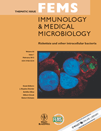Global gene expression profiling of Ehrlichia ruminantium at different stages of development
Abstract
Ehrlichia ruminantium (ER), the causative agent of heartwater on ruminants, is an obligate intracellular bacterium transmitted by ticks of the genus Amblyomma. Previous studies have shown that early stages of development may be critical for Ehrlichia pathogenicity. To gain insights into the biology of intracellular ER, we determined the genome-wide transcriptional profile of ER replicating inside bovine aortic endothelial cells using DNA microarrays. At intermediate and late stages of infection (reticulate and elementary bodies, respectively), a total of 54 genes were differentially expressed. Among them, we measured by q-RTPCR the overexpression of 11 of 14 genes. A number of genes involved in metabolism, nutrient exchange, and defense mechanisms, including those involved in resistance to oxidative stress, were significantly induced in ER reticulate bodies. This is consistent with the oxidative stress condition and nutrient starvation that seem to occur in Ehrlichia-containing vacuoles. During the lysis stage of development, when ER is infectious, we showed the overexpression of a transcription factor, dksA, which is also known to induce virulence in other pathogens such as Salmonella typhimurium. Our results suggest a possible role of these genes in promoting ER development and pathogenicity.




